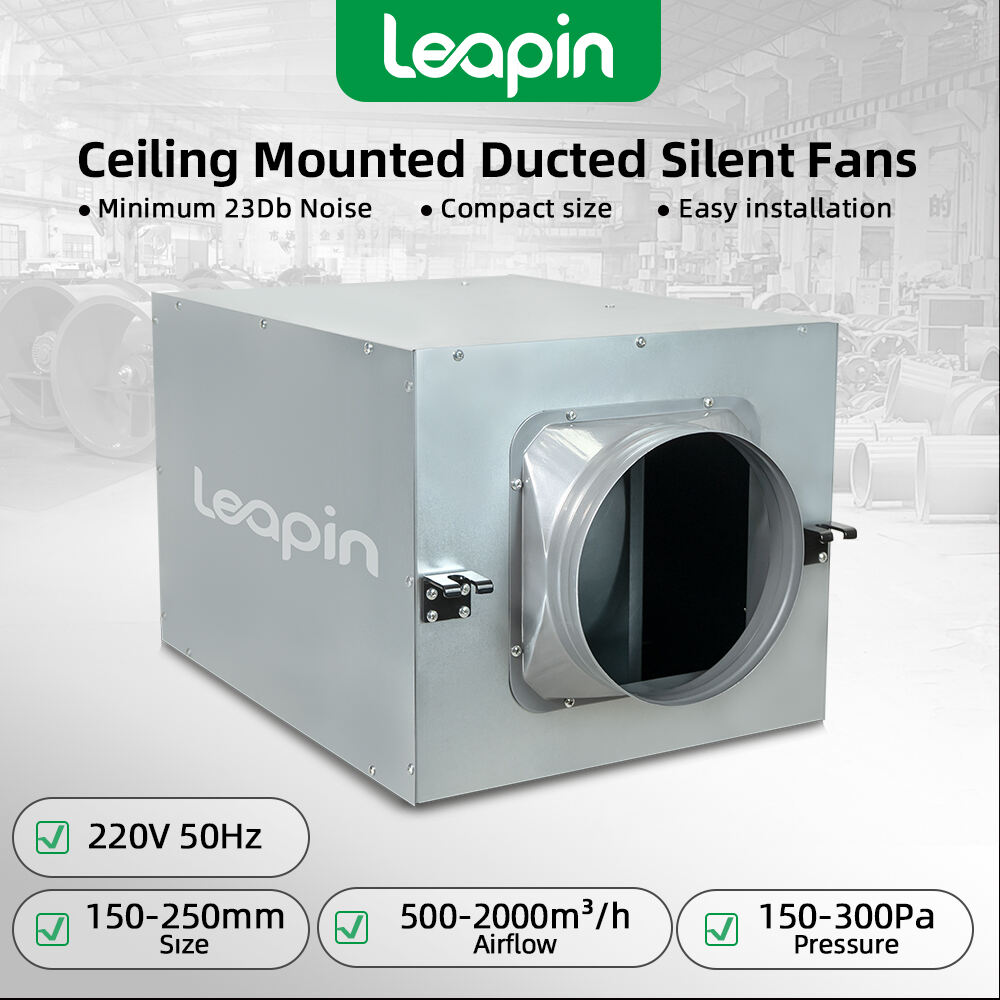Duct Fans: Exploring the Different Types and Their Benefits
Understanding Duct Fans and Their Core Functions
What Are Duct Fans?
Duct fans are mechanical devices specifically designed to facilitate air movement within ventilation systems. Their primary components include a motor, impeller, and housing, each serving a critical function to ensure efficient airflow. The motor powers the fan, the impeller directs the air, and the housing contains these elements, often designed to swiftly integrate into various duct systems due to their modular nature. This adaptability makes duct fans versatile in a wide array of commercial applications. Typically, these fans come in various sizes, with airflow capacities ranging to meet the demands of settings like warehouses or large industrial spaces. By moving air effectively, duct fans help maintain the desired air quality and temperature, vital for industrial and commercial operations.
How Duct Fans Improve Airflow Efficiency
The integration of duct fans significantly enhances airflow efficiency by optimizing air distribution dynamics. These fans are scientifically designed to manage airflow, reducing the static pressure within the ducts and thereby increasing the Cubic Feet per Minute (CFM), a key metric in measuring airflow. The increase in CFM indicates more air volume being moved through the system, which smooths out air distribution in both residential and commercial settings. For instance, in a commercial warehouse, duct fans can effectively circulate air to prevent hot spots and maintain consistent temperatures throughout the space. Experts in ventilation systems emphasize the importance of selecting the right type of fan, as the wrong choice can impede their performance, leading to inefficiencies and increased operational costs.
Types of Duct Fans for Diverse Applications
Inline Duct Fans: Compact and Versatile
Inline duct fans are essential components in both residential and commercial environments, offering compact design and versatile functionality. These fans are typically installed directly within the ductwork, allowing them to be integrated seamlessly into existing HVAC systems. Their space-saving nature makes them ideal for buildings where area is limited but airflow needs are high. Inline duct fans excel in air movement capabilities, often boasting superior metrics compared to traditional fan models. According to industry statistics, inline fans can move up to 1,300 CFM (Cubic Feet per Minute), significantly enhancing energy efficiency in HVAC systems. By employing these fans, facilities not only achieve better air distribution but also lower operational costs through improved energy efficiency.

Exhaust Duct Fans for Industrial Environments
Exhaust duct fans play a crucial role in industrial settings, primarily tasked with removing stale air and contaminants to improve air quality. These fans are designed to handle high volumes of air, featuring robust materials and specialized impellers that make them suitable for demanding environments like factories and kitchen applications. Their use is widespread in manufacturing plants where they contribute to compliance with air quality and safety regulations. For instance, a case study from a manufacturing facility revealed a 30% improvement in air quality after implementing industrial exhaust fans, greatly reducing the risk of respiratory issues among employees. It's clear that exhaust duct fans are vital for maintaining a healthy and efficient industrial environment.
Silent Duct Fans for Noise-Sensitive Spaces
Silent duct fans are engineered with advanced technologies to minimize noise output, making them ideal for noise-sensitive environments such as residential areas, libraries, and healthcare facilities. These fans utilize features like acoustic insulation and innovative motor designs to achieve near-silent operation. The benefits of a silent operation are manifold, including maintaining a peaceful atmosphere conducive to work or relaxation. Silent duct fans have garnered positive customer feedback, often outperforming traditional noisy options in reviews that emphasize their quietness and efficiency. This advancement in fan design not only enhances comfort but also ensures uninterrupted indoor activities, thus serving the diverse needs of different spaces effectively.
Benefits of Integrating Duct Fans into Ventilation Systems
Energy Efficiency and Cost Savings
Integrating modern duct fans with energy-saving technologies such as variable speed drives contributes significantly to energy efficiency. These technologies allow fans to operate at optimal speeds, reducing unnecessary energy use and thereby decreasing energy bills. For instance, data indicates that efficient duct fans can cut energy consumption by up to 30%, equating to substantial yearly savings. Experts highlight that investing in optimized ventilation systems not only offers long-term financial benefits but also positively impacts the environment by lowering overall energy consumption. By adopting these advanced systems, we can move towards a more sustainable future.
Low Noise Operation in Residential Settings
Low noise operation is crucial for maximizing comfort and well-being in residential settings. Silent duct fans are designed to comply with noise standards, ensuring that their operation doesn't disrupt daily life. Many users have attested to the peaceful environment these fans create, with testimonials emphasizing their quiet operation compared to traditional models. Technological advancements in recent silent duct fans have further enhanced their noise-reducing capabilities, making them ideal for maintaining tranquility in homes.
Enhanced Air Quality in Warehouses and Factories
Duct fans play a pivotal role in improving air quality within warehouses and factories by ensuring better air circulation and reducing pollutants. Research has consistently shown that improved ventilation directly correlates with enhanced workplace safety and productivity. In industrial settings, common air quality issues include the presence of dust, fumes, and chemical vapors, which duct fans effectively mitigate. The resulting increased worker satisfaction and performance underscore the importance of implementing these solutions. Data suggests that stringent ventilation can lead to a 10% boost in overall employee productivity, confirming the value of maintaining high air quality standards in industrial environments.
DPT Series Duct Fans: Engineered for Silent Performance
DPT Series Duct-Type Silent Fan: Features and Specifications
The DPT Series Duct-Type Silent Fan is designed for optimal airflow and quiet operation, making it an excellent choice for both residential and industrial environments. With an impressive airflow range of 500-2000 m³/h and maximum static pressure from 150-300 Pa, these fans efficiently facilitate air exchange while maintaining minimal noise levels, as low as 23 decibels. Notably, the forward-inclined impeller made of high-polymer materials minimizes wind noise through reduced air friction. Constructed from high-quality galvanized steel with a corrosion-resistant coating, these fans are not only durable but also aesthetically pleasing. When compared to competitors, the DPT Series fans stand out due to their perfect blend of efficiency and low-noise operation, aligning with industry standards and certifications. The compact and lightweight design further simplifies installation, making them a preferred choice for ceiling setups, particularly beneficial in environments with stringent noise restrictions.
Duct Silent Cabinet Box Inline Fans DPT Series: Applications and Advantages
The DPT Series Duct Silent Cabinet Box Inline Fans are crafted to serve a multitude of environments ranging from residential spaces to industrial sites. These fans excel in maintaining a tranquil ambiance, thanks to their robust design focused on silent operation and high performance. The compact structure allows for seamless integration even in constrained spaces, optimizing available areas. Testimonials from users highlight their reliable performance and ease of installation, significantly enhancing air quality and ventilation efficiency. Additionally, these fans' compatibility with automation technologies, including smart home systems, underscores their versatility for modern setups. This adaptability is invaluable, providing tailored ventilation solutions while retaining the core advantage of energy efficiency and noise reduction. Their comprehensive design meets various application needs, ensuring that environments maintain a balance of comfort and functionality.
Selecting the Ideal Duct Fan for Your Needs
Factors to Consider: Size, Static Pressure, and Environment
Choosing the right duct fan involves several key factors considering the size, static pressure, and environmental conditions. First, assessing the duct size is crucial, as it determines the fan's capacity to handle the airflow requirements. Second, understanding the static pressure, which refers to the resistance in the duct system, is essential in fan selection. Finally, environmental factors such as temperature and humidity can significantly impact fan performance; higher temperatures might require a fan with higher cooling capability. Ensure you follow a comprehensive checklist while making your decision, and always consider expert recommendations to avoid common pitfalls, such as sizing miscalculations or improper compatibility with existing systems.
Why the DPT Series Stands Out for Low-Noise Requirements
The DPT Series is engineered with unique features ideal for low-noise environments, making it stand out in the crowd of industrial fans. Its advanced design focuses on silent operation, using specialized fan blades and housing materials that reduce sound levels significantly. Compared to other fan types, which often fall short of meeting low-noise operational standards, the DPT Series maintains high performance with minimal disruption. Customers consistently provide positive feedback, applauding the DPT Series for its effectiveness at managing sound levels while delivering robust airflow. Additionally, this series has received several awards for its innovation in quiet fan technology, reinforcing its position as the top choice for sound-sensitive applications.

 EN
EN
 AR
AR
 FR
FR
 RU
RU
 ES
ES
 TL
TL
 ID
ID
 VI
VI
 TH
TH
 MS
MS
 BN
BN



